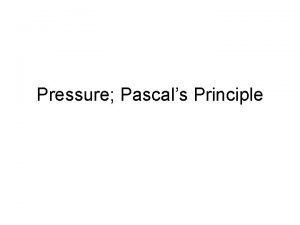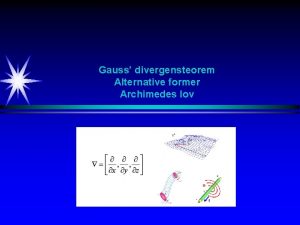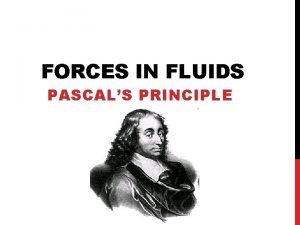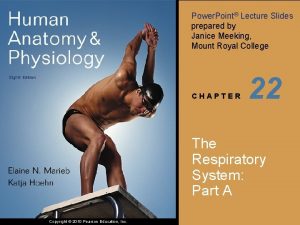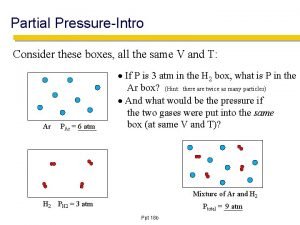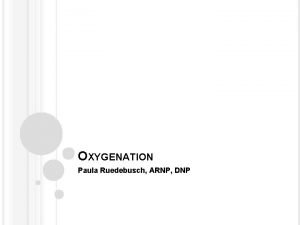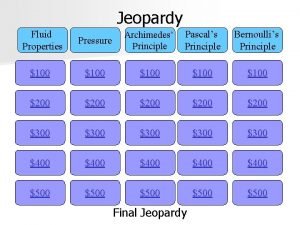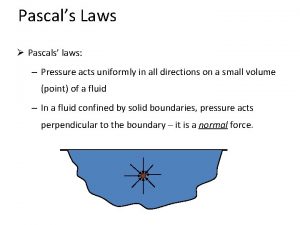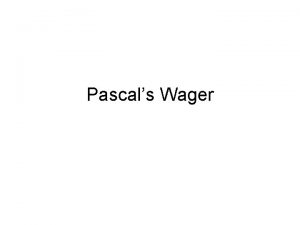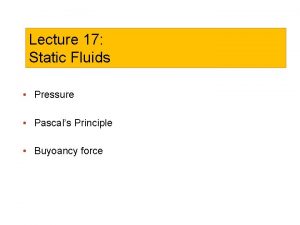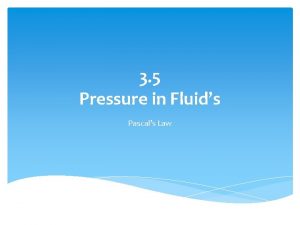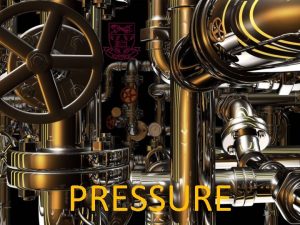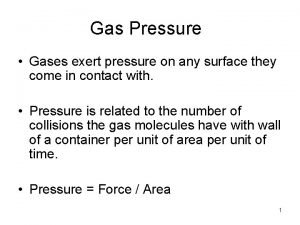Pascals Principle The pressure applied to any surface




















- Slides: 20

Pascal’s Principle – The pressure applied to any surface of a confined fluid is transmitted equally in every direction throughout the fluid.

Blaise Pascal. Christian Came up with first calculating machine. Euclidean Geometry

Hydraulic Press – One of the most important applications of Pascal’s Principle.

35 PSI 5 lbs 1 inch 7 inches Force = Pressure X Area

A small cylinder of a hydraulic press has an area of 3 in 2. If a force of 6 pounds is applied to the small piston, how much is the pressure within the larger cylinder increased? = 6 pounds / 3 in 2 2 psi

The large cylinder of a hydraulic press has an area of 50 in 2. What will be the force upon it if a pressure of 10 psi is produced by the small piston? = 10 psi x 50 in 2 500 pounds

Robert Boyle Christian that helped fund the translation of the Bible. Improved vacuum pump Father of Modern Day Chemistry.

Boyle’s Law – If the temperature of a gas remains constant, its volume and pressure are inversely related. P 1/P 2 = V 2/V 1

If a pressure of 20 psi on a volume of 10 in 3 is reduced to 4 psi, by what factor does the pressure change? 20 psi/4 psi = 5

If the pressure of a gas triples, how does the volume of the gas change? Since pressure and volume are inversely related, it decreases by the inverse. The inverse of 3/1 is 1/3.

If the volume of a gas triples, how does the pressure of the gas change? Since pressure and volume are inversely related, it decreases by the inverse. The inverse of 3/1 is 1/3.

If a mass of air in a basketball has a pressure of 30 psi and a volume of 20 in 3 , what will be the new pressure if it is compressed to a new volume of 10 in 3 ? 30 psi / P 2 = 20 in 3 / 10 in 3 Solve for P 2 = 60 PSI

Charles’s Law – If the pressure of a gas remains constant, its volume and temperature are directly related. V 1/T 1 = V 2/T 2

Combined Gas Law– If the volume of a gas remains constant, its pressure and temperature are directly related. P 1/T 1 = P 2/T 2

If the volume of a gas is tripled, how does the absolute temperature of the gas change? Since temperature and volume are directly related, it is also tripled.

If the absolute temperature of 12 in 3 of a gas decreases by a factor of 2, what will be the new volume? Since temperature and volume are directly related it will also decrease by a factor of 2. 12 in 3 / 2 = 6 in 3

If the pressure of a gas is tripled, how does the absolute temperature of the gas change? Since temperature and pressure are directly related, it is also tripled.

If the absolute temperature of a gas with a pressure of 20 psi increases by a factor of 2, what will be the new pressure? Since temperature and pressure are directly related it will also increase by a factor of 2. 20 psi x 2 = 40 psi

Absolute Zero - The point at which molecules have no heat energy and therefore do not move. This is the lowest possible temperature. -273. 15 Celsius, -459. 67 Fahrenheit.

Kelvin Scale - The scale of absolute temperature. Absolute Zero is 0 Kelvin. K = Celsius + 273. 15 Use K reading in equation for Charles’ Law
 ρhg
ρhg What does pascal's principle state apex
What does pascal's principle state apex Pascals identity
Pascals identity Binomial distribution pascal's triangle
Binomial distribution pascal's triangle How to find pressure potential
How to find pressure potential Pascals identity
Pascals identity History of pascal's triangle
History of pascal's triangle Pascals lov
Pascals lov Pascal principle examples in real life
Pascal principle examples in real life Pascals triangle 8
Pascals triangle 8 There aren't any bananas
There aren't any bananas Any to any connectivity
Any to any connectivity Any question atau any questions
Any question atau any questions Vmo advancement cpt
Vmo advancement cpt Pressure support vs pressure control
Pressure support vs pressure control Pressure mapping for pressure ulcers
Pressure mapping for pressure ulcers Intrapulmonary pressure
Intrapulmonary pressure Oncotic pressure
Oncotic pressure Partial pressure formula
Partial pressure formula Intra plural pressure
Intra plural pressure How are metamorphic rocks classified
How are metamorphic rocks classified
